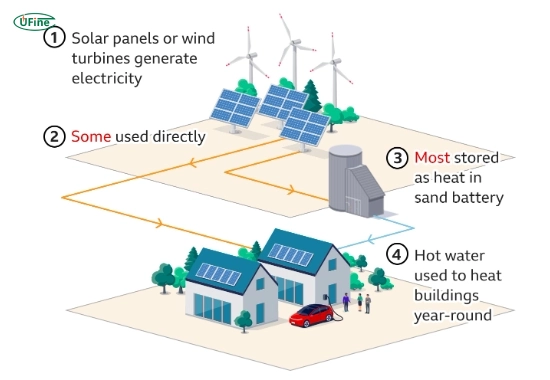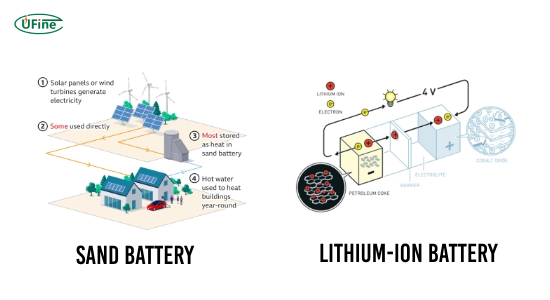
- Part 1. What is a sand battery and how does it work?
- Part 2. What is a lithium-ion battery and how does it function?
- Part 3. Key differences between the sand battery and the lithium-ion battery
- Part 4. Why are sand batteries more sustainable than lithium-ion batteries?
- Part 5. Can sand batteries compete in energy efficiency with lithium-ion batteries?
- Part 6. In what applications do sand batteries outperform lithium-ion batteries?
- Part 7. Are sand batteries safer than lithium-ion batteries?
- Part 8. What are the challenges of sand battery technology?
- Part 9. How does the cost compare between sand batteries and lithium-ion batteries?
- Part 10. Will sand batteries replace lithium-ion batteries in the future?
- Part 11. FAQs about the sand battery and the lithium-ion battery
Sand battery technology is gaining attention as a sustainable and cost-effective alternative to lithium-ion batteries. So, what exactly is a sand battery, and how does it compare to the widely used lithium-ion battery? In this comprehensive guide, we explore both technologies, analyze their strengths and weaknesses, and explore which one is better suited for our energy future.
Part 1. What is a sand battery and how does it work?
A sand battery is a thermal energy storage system that uses silica sand to store heat generated from renewable electricity sources like solar or wind. The system charges by heating sand to high temperatures, often over 500°C (932°F), then storing that heat in an insulated steel container.
Here’s how it functions:
- Charging phase: Renewable electricity powers resistive heating elements that heat the sand.
- Storage phase: The hot sand retains the thermal energy for extended periods due to its insulating properties.
- Discharge phase: The stored heat is extracted and used to heat buildings and industrial processes or converted into electricity through steam turbines.
This technology is ideal for long-duration energy storage, especially in cold climates where thermal energy is essential.
Part 2. What is a lithium-ion battery and how does it function?
A lithium-ion battery is a chemical energy storage device that stores and releases electrical energy through electrochemical reactions. It consists of four main components:
- Cathode (positive electrode)
- Anode (negative electrode)
- Electrolyte (facilitates ion movement)
- Separator (prevents short-circuiting)
Lithium ions move from the anode to the cathode when the battery discharges, generating an electric current. During charging, the process is reversed.
Lithium-ion batteries are used in:
- Smartphones and laptops
- Electric vehicles (EVs)
- Solar energy storage systems
- Power tools and household electronics
Part 3. Key differences between the sand battery and the lithium-ion battery
Understanding the comparison between sand and lithium-ion batteries is crucial for evaluating their real-world applications. Below is a table with real data and performance metrics:
| Feature | Sand Battery | Lithium-Ion Battery |
|---|---|---|
| Energy Storage Form | Thermal (heat) | Chemical (electricity) |
| Energy Density | ~0.1–0.2 kWh/kg | ~150–250 Wh/kg |
| Round-trip Efficiency | ~80% | ~90–95% |
| Lifespan | 20–30 years | 5–10 years |
| Charge/Discharge Time | Hours | Seconds to minutes |
| Recyclability | 100% (sand & steel) | ~50–70% |
| Raw Materials | Silica sand, steel | Lithium, cobalt, nickel |
| Cost per kWh (2024 est.) | $10–$20 | $135–$200 |
| Fire Risk | Very low | High (thermal runaway) |
| Best Use Case | Grid-scale heat storage | Mobile electronics, EVs |
As shown, each battery type excels in different areas depending on the application.
Part 4. Why are sand batteries more sustainable than lithium-ion batteries?
Sand batteries are significantly more eco-friendly for several reasons:
- Abundant raw materials: Sand is one of the most common materials on Earth, unlike lithium and cobalt, which are mined in limited regions.
- Low environmental impact: No toxic chemicals, no water-intensive mining, and no complex recycling processes.
- Non-toxic and safe: Sand poses no danger to humans or ecosystems.
- No hazardous waste: Lithium-ion batteries, when disposed of improperly, can leak harmful chemicals into the environment.
In contrast, lithium-ion batteries contribute to habitat destruction, water pollution, and human rights issues in mining regions.
Part 5. Can sand batteries compete in energy efficiency with lithium-ion batteries?
While lithium-ion batteries are more efficient in converting electricity, sand batteries still perform well in key applications:
- Lithium-ion batteries have a round-trip efficiency of 90–95%, meaning most of the energy put in can be recovered.
- Sand batteries offer 75–80% thermal efficiency, which is excellent for heating and industrial applications.
Lithium-ion wins for direct electricity storage and quick discharges. However, sand batteries are extremely effective in storing large amounts of renewable energy and delivering it over long durations.
Part 6. In what applications do sand batteries outperform lithium-ion batteries?
Sand batteries shine in areas where heating and long-term storage are required:
- District heating systems in northern Europe
- Industrial processes needing high-temperature heat
- Remote renewable energy installations where electricity is converted to thermal energy for storage
Unlike lithium-ion systems, sand batteries do not degrade with each cycle. They can store energy for months without significant loss, making them ideal for seasonal storage.
Part 7. Are sand batteries safer than lithium-ion batteries?
Safety is where sand batteries have a major advantage:
- They do not contain flammable or reactive chemicals.
- They are not sensitive to overcharging or punctures.
- There is no risk of thermal runaway, which causes fires in lithium-ion systems.
In residential or urban settings where fire risk is a concern, sand batteries offer a more secure option.
Part 8. What are the challenges of sand battery technology?
Although promising, sand batteries face certain limitations:
- Energy conversion: Turning heat back into electricity is still less efficient than chemical batteries.
- Size and weight: Sand batteries are bulky and heavy, making them unsuitable for mobile use.
- Technology maturity: As of 2025, sand batteries are still in the early stages of commercialization.
However, pilot projects in Finland and Germany show great potential, and research investments are growing rapidly.
Part 9. How does the cost compare between sand batteries and lithium-ion batteries?
Cost is a key factor in energy storage decisions:
- Sand batteries cost around $10–$20 per kWh of storage capacity (thermal), making them one of the cheapest options available.
- Lithium-ion batteries cost between $135 and $200 per kWh, depending on scale and chemistry.
For utility-scale renewable energy storage and heating grids, sand batteries are far more cost-effective over the system’s lifetime.
Part 10. Will sand batteries replace lithium-ion batteries in the future?
Not exactly—but they will play a complementary role.
Lithium-ion batteries will remain dominant for:
- Electric vehicles
- Consumer electronics
- Backup power systems
Sand batteries will grow in:
- Grid-level renewable energy storage
- District heating systems
- Industrial heat applications
Each technology solves a different problem. The future of energy storage will likely involve a hybrid approach, using both sand and lithium-ion batteries where each fits best.
Part 11. FAQs about the sand battery and the lithium-ion battery
What is a sand battery used for?
A sand battery stores thermal energy, mostly for heating purposes and industrial applications. It stores excess electricity from renewable sources as heat inside a sand-filled, insulated container.
Are sand batteries better than lithium-ion batteries?
Sand batteries are better for large-scale, long-term heat storage, while lithium-ion batteries are better for portable electronics and quick power delivery.
How long does a sand battery last?
A well-maintained sand battery system can last 20 to 30 years with minimal performance loss.
Are sand batteries safe for residential use?
Yes, sand batteries are extremely safe. They do not pose any fire or explosion risks, making them suitable for residential and industrial environments.
Can a sand battery power my home appliances?
Not directly. Sand batteries store heat, not electricity. However, they can provide heating or be integrated into systems that convert heat into electricity using turbines.
Related Tags:
More Articles

A Complete Guide to the Best Batteries for Flashlights
Discover the best batteries for flashlights: alkaline, lithium, NiMH & rechargeable options. Tips for performance and maintenance.
Graphene Battery vs Lithium Battery: Which is Better?
Compare graphene battery vs lithium battery in energy density, charging speed, lifespan, cost, and EV applications. Learn which battery leads in 2025.
What is the Difference Between MCA and CCA on Batteries?
Learn the difference between MCA and CCA batteries. Understand what MCA means, what CCA is, and how to choose the right battery for vehicles or marine engines.
Type of Lithium Battery Voltage
Learn lithium ion battery voltage, nominal voltage, and voltage range. Compare Li-ion, LiPo, LiFePO4, and 18650 voltages, charging, and device compatibility.
Gel Battery vs Lead Acid: A Detailed Comparison
Compare gel and lead-acid batteries: lifespan, cost, charging, DoD, safety, and key use cases. Find the right battery for solar, marine, EV, UPS, and daily use.





